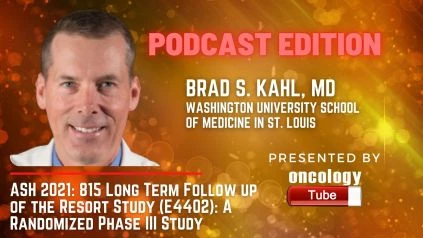Brad S. Kahl, MD, Professor of Medicine, Division of Oncology, Washington University School of Medicine in St. Louis speaks about the ASH 2021 Abstract 815 Long Term Follow up of the Resort Study (E4402): A Randomized Phase III Study Comparing Two Different Rituximab Dosing Strategies for Low Tumor Burden Follicular Lymphoma.
Link to Abstract:
https://ash.confex.com/ash/2021/webprogram/Paper152976.html
Context:
E4402 was a randomized phase III trial that compared two alternative rituximab dosing techniques for individuals with low tumor burden follicular lymphoma who had previously been untreated (FL). The time to treatment failure was the primary outcome. The first study (Kahl, JCO 2014) found that a retreatment strategy used less medicine and resulted in a similar time to treatment failure as a maintenance strategy. Long-term follow-up outcomes are presented here, with an emphasis on response length, time to first cytotoxic therapy, overall survival, and the risk of histologic transformation.
Methodologies:
Patients who were eligible had FL that was untreated and had a modest tumor load (based on the GELF criteria). Responders were randomized to maintenance rituximab (MR) (single dose R q 3 months) or retreatment rituximab (RR) after receiving R 375 mg/m2 weekly for four weeks (R weekly x 4 doses at disease progression). Each technique was carried out until the treatment was no longer effective. Time to treatment failure, the primary outcome, was defined as advancement within 6 months of the previous R, no response to R retreatment, beginning of alternative therapy, or inability to complete protocol therapy. Time to initial cytotoxic therapy, quality of life, and safety were all secondary goals. In September 2011, the ECOG Data Monitoring Committee recommended that trial data be released at a planned intermediate analysis, and patients and providers were notified of the findings. With the announcement of the results, data collecting on time to first cytotoxic therapy, response duration, and risk of histologic transformation came to a halt, but restricted data collection on time to first cytotoxic therapy, response duration, and risk of histologic transformation remained.
PRIMARY RESULTS:
From November 2003 to September 2008, 384 participants with FL were included in the study. 289 individuals (71%), who were then randomized to MR (n=146) or RR (n=143), had a complete or partial response. The two arms had similar demographics: median age 59 years; all patients had ECOG PS 0-1; had FLIPI low-risk (14.9 vs. 16.4%), intermediate-risk (46.3 vs. 42.9 percent), and high-risk (38.8 vs. 40.7 percent) for MR vs. RR, respectively. With a median follow-up of 3.8 years at the time of initial publication, the time to treatment failure for MR was 3.9 years vs. 3.6 years for RR (p=NS).
RESULTS OF LONG-TERM FOLLOW-UP:
At the annual meeting, immunoglobulin levels and the risks of major infections/late complications in MR patients will be updated. The median follow-up for the endpoint of time to first cytotoxic therapy is 8.7 years. [Figure 1] At 7 years, 83 percent of MR and 63 percent of RR had not received their initial cytotoxic therapy (HR 2.37; 95 percent CI 1.50 – 3.76) The median follow-up time for the response duration endpoint is 12.1 years. At ten years, 66 percent of MR patients were still in their first remission, but only 30% of RR patients were still in their first remission [Figure 2]. Patients with RR who had a single 4-week dose of rituximab had a median response time of 3.25 years. At ten years, there was no difference in overall survival between MR and RR, with 84 percent for MR and 83 percent for RR. Patients who received MR (n = 4) had a reduced likelihood of histologic transformation than those who received RR (n = 11) (p = 0.11).
Outcomes:
The RESORT data show that in previously untreated, low tumor burden follicular lymphoma, MR was superior to RR in terms of delaying time to begin cytotoxic therapy and response duration, with a trend toward lowering the probability of histologic transformation. Overall survival was not improved by MR. The original study concluded that the two dosage methods have similar times to treatment failure. The time to treatment failure could not be assessed in this long-term follow-up research due to the study design. When compared to the historical benchmark of 3 years median time to first cytotoxic therapy when watch and wait are used, single-agent rituximab was significantly effective at delaying the time to first cytotoxic therapy when delivered by either dosing strategy.

